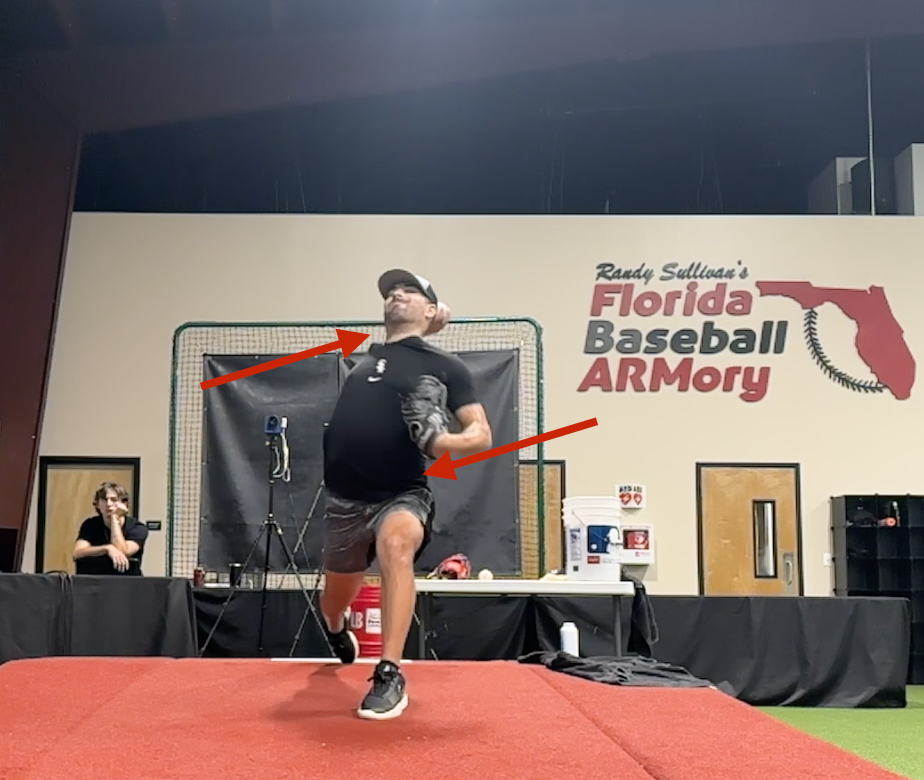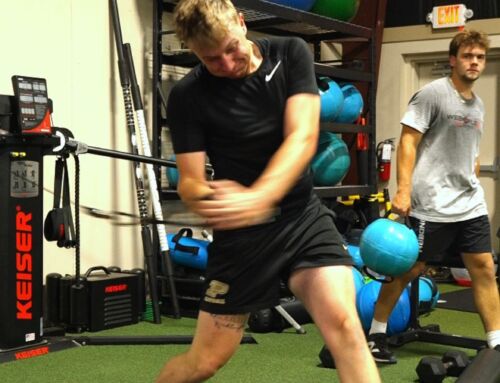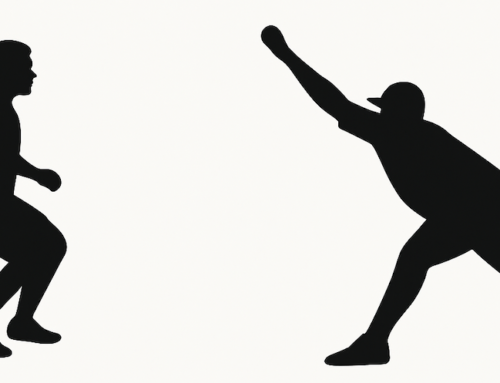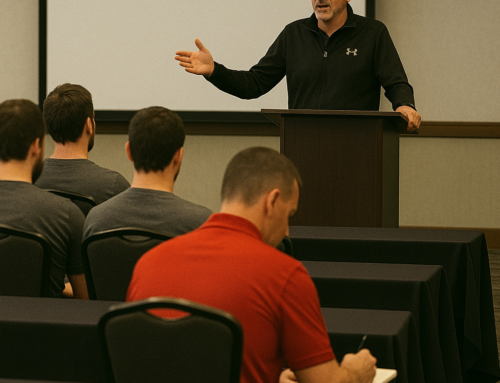
“I just can't recruit a kid whose hat falls off on every pitch.”
— Division 1 Pitching coach
In high-level pitching, efficiency and motor control are everything. Coaches and players spend countless hours refining mechanics, searching for a delivery that maximizes velocity, command, and durability. While many factors influence a pitcher’s success, one often-overlooked but critical element is head stability. Keeping the head still, especially relative to the spine, enhances a pitcher's ability to gather and react to essential perceptual cues, promotes efficiency in movement, and ensures better self-organization in accordance with the body's natural principles of motor control.
What Are Specifying Variables and Why Do They Matter?
Pitching mechanics do not occur in a vacuum. Interpreting and responding to the information presented by the external and internal environment is integral to quality movement. This is known as perception-action coupling, the process by which an athlete gathers sensory information and translates it into movement. The ability to throw a strike, adjust to a hitter’s reaction to a pitch, or refine a breaking ball all depends on accurately perceiving relevant environmental and internal cues known as “specifying variables.”
Specifying variables are the key pieces of information that directly guide an athlete’s actions. In pitching, these include:
- Vestibular information about the body’s orientation in space
- Proprioceptive information received from the internal environment.
- Visual information gathered as the body moves down the mound
- The intended target and release point
- The batter’s location and posture in the box
- The field conditions (such as the mound height and slope)
If a pitcher’s head is moving too much, it makes it harder for them to receive and process this critical information. I’ve never seen a great sprinter, running back, or jungle tiger cruising with their head banging around. A still head allows the pitcher to gather more accurate sensory information, improving motor control and movement efficiency.
The Four Minimums and Why They Matter![]()
The human body self-organizes around four key principles to optimize movement: minimum jerk, minimum torque change, minimum processing, and minimum energy cost. These principles ensure that movement is smooth, efficient, and effective. Keeping the head still directly supports all four principles:
- Minimum Jerk (Smooth Movement) – Sudden or excessive head movement disrupts the smooth sequencing of the kinetic chain. If a pitcher yanks their head aggressively to the side at ball release, it creates instability and inconsistency. Likewise, in a circular relationship, jerky movement can prevent the pitcher from keeping their head still.
- Minimum Torque Change (Efficient Joint Use) – The body naturally seeks to minimize unnecessary separation of its parts that can lead to stress on the joints. If a pitcher’s head moves erratically, it often correlates with instability in the spine, forcing excessive adjustments in the hips, shoulders, and arms. A still head allows for and suggests natural and efficient joint mechanics.
- Minimum Processing (Reducing Cognitive Load) – The body prioritizes efficiency by reducing the number of decisions and actions required to complete a movement. If a pitcher’s head moves unpredictably, it creates additional sensory input that the brain must process, slowing down information processing and disrupting flow.
- Minimum Energy Cost (Conserving Energy) – Pitching is an explosive, high-energy action. Any unnecessary movement burns energy that could be better used for power, endurance, and control. Excessive head movement creates instability that forces the body to work harder than necessary, leading to early fatigue and decreased performance.
Head Stability and Lumbar Stability: The Core of Pitching Success
The head is intricately linked to the stability of the entire system. When the head remains still, it serves as an indicator of strong lumbar stability, thoracic mobility, and cervical stability—three key factors for optimal motor control.
- Lumbar Stability (Lower Back Control) – The lumbar spine is the foundation for rotational power and energy transfer. If the lower back is unstable, the head often moves excessively as a compensatory mechanism. A still head suggests that the lumbar spine is providing the necessary support for efficient movement.
- Thoracic Mobility (Upper Back Flexibility) – The ability to extend and rotate the thoracic spine is crucial for achieving optimal abdominal length. When the thoracic spine moves freely while the lumbar spine remains stable, a pitcher can more efficiently transfer energy from the lower body to the arm. Excessive head movement is often a sign that thoracic mobility is lacking, forcing the body to seek rotation elsewhere in inefficient ways.
- Cervical Stability (Neck Control) – The neck serves as a crucial connection between the head and the rest of the body. When the head moves too much, it places undue stress on the cervical spine, disrupting vestibular sense and motor control. A still head indicates that the cervical spine is doing its job—maintaining alignment and allowing the eyes to process information accurately.
When the lumbar spine lacks stability, the neck becomes unstable, and the head often jerks sideways or snaps upward, resembling a Pez dispenser. Likewise, if the back leg becomes overactive, or the pitcher jumps off the mound instead of driving efficiently, the head can bounce up and down like a roller coaster throughout the delivery. This mirrors what happens when a hitter lunges at a juicy fastball—excessive head movement disrupts vision, timing, and barrel accuracy.
The Impact on Command, Velocity, and Injury Prevention
A still head has direct benefits for command, velocity, and injury prevention.
- Command – Pitchers who keep their heads still move more efficiently and receive perceptual information more clearly. This positively influences command.
- Velocity – Energy leaks occur when the body compensates for instability, large separations, or jerky movements. Keeping the head still ensures that all generated force is directed toward the arm, the ball, and ultimately the target rather than being wasted in unnecessary movements.
- Injury Prevention – Excessive head movement is often linked to poor postural control, leading to increased stress on the spine, shoulder, and elbow. By maintaining head stability, pitchers reduce unnecessary strain and lower their risk of injury.
Pitching involves a complex relationship between perception and action, stability and mobility, and power and control. While many elements contribute to success on the mound, keeping the head still is a fundamental principle that cannot be overlooked. A still head enhances the ability to perceive specifying variables, aligns with the four minimums of movement efficiency, and promotes lumbar stability, thoracic mobility, and cervical stability—all of which are essential for peak performance.
For parents, coaches, and athletes striving to maximize pitching potential, focusing on head stability is a simple yet powerful adjustment that can lead to better command, higher velocity, and a lower risk of injury.
The bottom line, you might say, is to stay calm, move well, and keep your head still.
If you or someone you know is ready to take the pitching game to new heights, check out one of our world-class programs:
A high-intensity, immersive weekend designed for pitchers looking to refine mechanics, increase velocity, and improve command. Athletes receive expert coaching, individual assessments, and data-driven feedback in a fast-paced environment.
Ideal for players seeking rapid improvement and actionable takeaways. Perfect for those who want a quick but impactful training experience without a long-term commitment.
Extended Stay SAVAGE Summer Training:
A comprehensive, multi-week summer program where athletes train five days a week, focusing on throwing, mobility, arm care, SAVAGE strength, power development, and Broga (yoga for dudes). Personalized plans ensure maximum progress.
Provides pitchers with deep, long-term development. Athletes build sustainable movement patterns, increase coordinated, strength, and develop skills that transfer directly to game performance.
Private, individualized training with Randy Sullivan, focusing on a pitcher’s unique needs. Sessions are fully customized, using high-tech analysis and targeted drills to optimize mechanics, velocity, and command.
Offers the highest level of personalized coaching, ensuring a laser-focused approach to development. Ideal for athletes who want elite-level attention and breakthrough results.
A remote training option for pitchers who can’t attend in person. Includes a customized training plan, video analysis, and ongoing coaching feedback from the ARMory team.
Allows athletes to train effectively from anywhere while still receiving expert guidance. Perfect for those who want a structured, high-level training program without needing to relocate.
Let's Get SAVAGE!

Randy Sullivan, MPT, CSCS CEO, Florida Baseball ARMory




